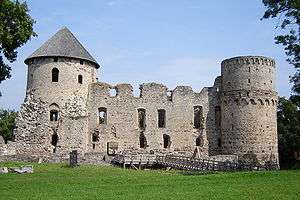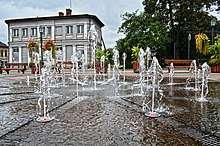Cēsis
Cēsis (Livonian: Venden, German: Wenden) is a town in Gauja National Park, in the Vidzeme region of Latvia, located on the Gauja river, roughly 100 km to the east of the capital Riga..
Understand

Having only around 18,000 inhabitants, it is a fairly quiet historic town, containing two beautiful castles and parks, houses built in various different time periods and small cobbled streets in the Old Town.
The name Venden or Wenden, respectively, is derived from the Venden, an ethnicity who lived in this place in the 12th century. It is not entirely certain, but they probably spoke a Finnish-Oegonian language.
At the beginning of the 13th century the area was conquered by the Order of the Sword Brothers. Under their regime, in 1206, Cēsis received city rights. Among the Sword brothers and their successors, Cēsis became a prosperous city. In the 14th century the city became Hanseatic.
In 1578, Stefanus Báthory, King of Poland and Grand Duke of Lithuania, defeated in Russian Tsar Ivan IV, who had invaded Livonia. Livonia was already paying taxes to the Polish king, but in 1598 the city became fully Polish and the capital of the Voivodeship Wenden.
In 1621, the city became Swedish and Russian in 1703. That remained the situation until the Latvian independence in 1918. However, the Polish, Swedish and Russian rule did not reduce the dominant position of the German-speaking elite in Livonia, which had settled here in the Middle Ages as landowners and merchants. Most local executives, as well as notaries, judges and lawyers, were Baltic Germans. But after Latvia became independent their influence changed.
Although the street patterns of the city date back to the Middle Ages, no medieval buildings have been preserved. In the course of history, Cēsis was rebuilt almost the same three times – the last time in 1703. Thus, the oldest buildings date back to the 18th century.
Get in
1188.lv provides up-to-date bus and train schedules, route planner and prices.
By bus
Many bus routes exist in the region. Direct connections between Cēsis and other nearby large cities such as Riga and Valmiera exist and departures are fairly frequent - usually once an hour. Connections with smaller towns exist, but may be less frequent, depending on the time of day.
Many buses in the region provide free WiFi access, especially on longer distance routes.
By train
There are some train routes going through Cēsis, connecting major cities such as Riga (€3.50), Sigulda (€2), Valmiera (€1.55) and Valga, Estonia (€2.90).
By car
Getting into Cēsis by car is fairly simple. The A2/E77 heads out of Riga in a north-eastern direction and can be followed until the P20 which can then be followed north until turning off west into the town. If following the A2/E77 from a town further east, the P30 (turn-off from A2/E77) can take you straight into Cēsis. From northern towns such as Valmiera, simply following the P20 south until turning off to Cēsis in a similar fashion as when driving from Riga. Following the P14 south-east will also take you straight into Cēsis.
Various turnoffs can be taken from the P20 depending on what the end destination in Cēsis is exactly and should probably be evaluated beforehand.
Get around
By foot
The town center is fairly small and can be traversed by foot. Practically all sidewalks are asphalted or have flat brick tiling.
By taxi
Local taxi companies exist and are reasonably priced making them a viable method of getting around. Regardless, you should always keep an eye out for possible scams related with overpricing such as bumping the meter price up with a touch of a button on the meter.
By bus
Local public transport exists, but the count of bus departures throughout the day is fairly low making walking to the destination often a much more viable opinion.
See
- Old Town (Vecpilsēta). 24/7. Various wooden buildings from the 18th and 19th centuries still standing.
- 🌍 Cēsis Castle Complex, Pils laukums 9–11. May-Sep: M-Su 10:00-18:00; Oct-Apr: Tu-Sa 10:00-17:00, Su 10:00-16:00. Complex with the Medieval Castle, the New Castle and the Cēsis History and Art Museum. The most famous building of Cēsis is the castle, for which construction began in 1209. Before, there was a wooden castle of the Venden people here. The castle became the residence of the Order of the Sword Brothers. It was destroyed in 1577, rebuilt, and destroyed again in 1703. At the end of the 18th century, part of the ruins where used as country house of Count Sievers, the then owner of the castle site. One of the towers was included in his country house. Nowadays, the included city museum is located in that building. The rest of the castle is still mostly in ruins. €4.
- 🌍 St. John's Church (Svētā Jāņa baznīca), Lielā Skolas iela 8. Sa Su 11:00-17:00. Built in the 13th century (1281-1284) with the spire built in 1853. Currently a Lutheran church. Climbing up in the tower provides a nice view over the Old Town and surroundings, including an exhibition. But the view at the top is partly blocked by a fence, which is OK for a smartphone but not a regular camera. It provides a view of the nearby castle complex. One tombstone commemorates the bishop Andrzej Patrycy Nidecki. €2 for the tower.

- 🌍 Square of Roses (Rožu laukums) (in front of St. John's Church). 24/7. Do not expect any roses though.
- 🌍 Unity Square (Vienības laukums), Vienības laukums. 24/7. Contains the Victory Monument, commemorating the Latvian Warriors who were killed during the Independence War (1918-1920). During the Soviet occupation, the monument was blown up but later in 1998 rebuilt.
- 🌍 Līvu Square (Līvu laukums), Rīgas iela 47 (south of Castle Park). 24/7. Has a fountain that is illuminated at night.
- 🌍 May Park (Maija parks) (on the opposite side of Lenču Str from Castle Park). 24/7.
- 🌍 Svētavots Nature Park and Holy Spring, Atpūtas iela 12 (in the western outskirts).
Do
- Cēsis is located on the edge of the Gauja National Park (Latvia's largest national park). Hikes through unspoilt nature are a welcome relief for those visiting the city.
- 🌍 The oldest brewery in Latvia (Cēsu alus darītava), Aldaru laukums 1, ☎ +371 64122423, e-mail: cesualus@cesualus.lv. Erected in 1878 on the grounds of the older brewery.
- 🌍 Ski Centre Žagarkalns, ☎ +371 26266266, e-mail: info@zagarkalns.lv. During season: Tu-F 15:00-23:00, Sa 10:00-23:00, Su 10:00-21:00. During the last hour each day, cleanup starts to take place on slopes one by one.. €15-18 for a 1-day adult ski pass.
- 🌍 Ieriķu nature trail (Cecīļu dabas taka), Ieriķu dzirnavas, ☎ +371 28396804, +371 28721839, e-mail: meiere.ieva@gmail.com. €3 (adult).
- Parachute jumping at Vidzeme Aero-club.
Buy
Rīgas iela is the central walking street in the Old Town with a couple of shops and restaurants.
Eat
- 🌍 Kafetērija Cēsis. M–Sa 07:30–19:00, Su 09–17:00. Authentic local style inexpensive bite. Salads, meat, fish, cake – all self made. Salads from €0.25/100g, coffee €0.90.
- 🌍 Cafe Popular, Vienības laukums 1 (on the side of Hotel Cēsis), ☎ +371 64120122. M 11:00–20:00, Tu-Th 11:00–21:00, F Sa 11:00–23:00, Su 12:00–20:00. Pizzas. Daily bistro. Summer terrace. $$.
Sleep
- 🌍 Hotel Buts, Bērzaines iela 15, ☎ +371 27890037, +371 27898049. Budget.
- 🌍 Hotel Cēsis, Vienības laukums 1 (next to the Victory Monument), ☎ +371 64120122, e-mail: reservation@hotelcesis.com. From €35.
Go next
- Ligatne – A village fairly well known for its nature trails, with a great natural park with wildlife animals and "fairy tale" forests with characters from famous Latvian fairy tales. Nearby, also an old Soviet bunker complex can be visited, which was built in case of a nuclear war.
- Sigulda – A town with many interesting castles and historic points of interest. Probably, the most popular destination outside of Riga for foreign tourists, also due to its closeness.
- Smiltene – Features a manor, some castle ruins, and a sight tower over the surrounding area.
- Jaunpiebalga – With a museum of the Latvian composer Emils Darzins (1875-1910) at the nearby "Jāņaskola".
- Madona – A scenic town surrounded by hills, forests and lakes, and a winter sports centre.
- Valmiera – Features the only professional theatre in the region, castle ruins, a medieval church, a famous brewery, and is the start of the Gauja National Park.
- Seda – Founded in 1953 in an uninhabited area, it still embodies the pomp of Communist and Stalinist shock-work aka architecture. Nearby a vast man-made peat bogs nature area can be found, and is not to be missed. Both occurrences are historically tied to each other.